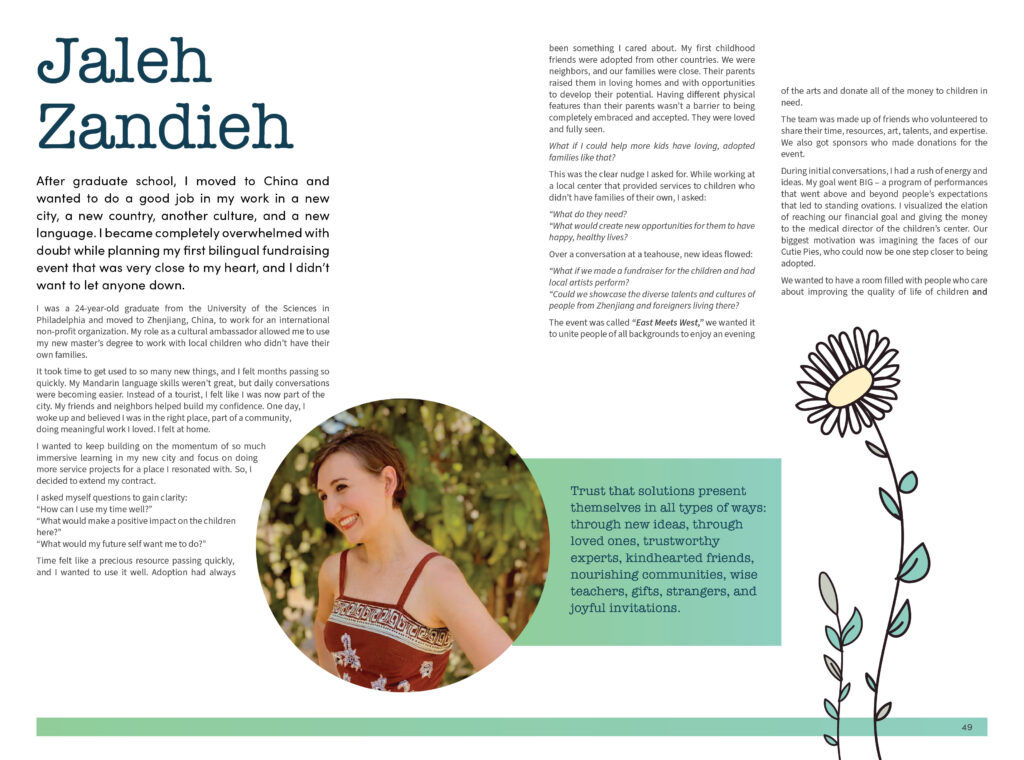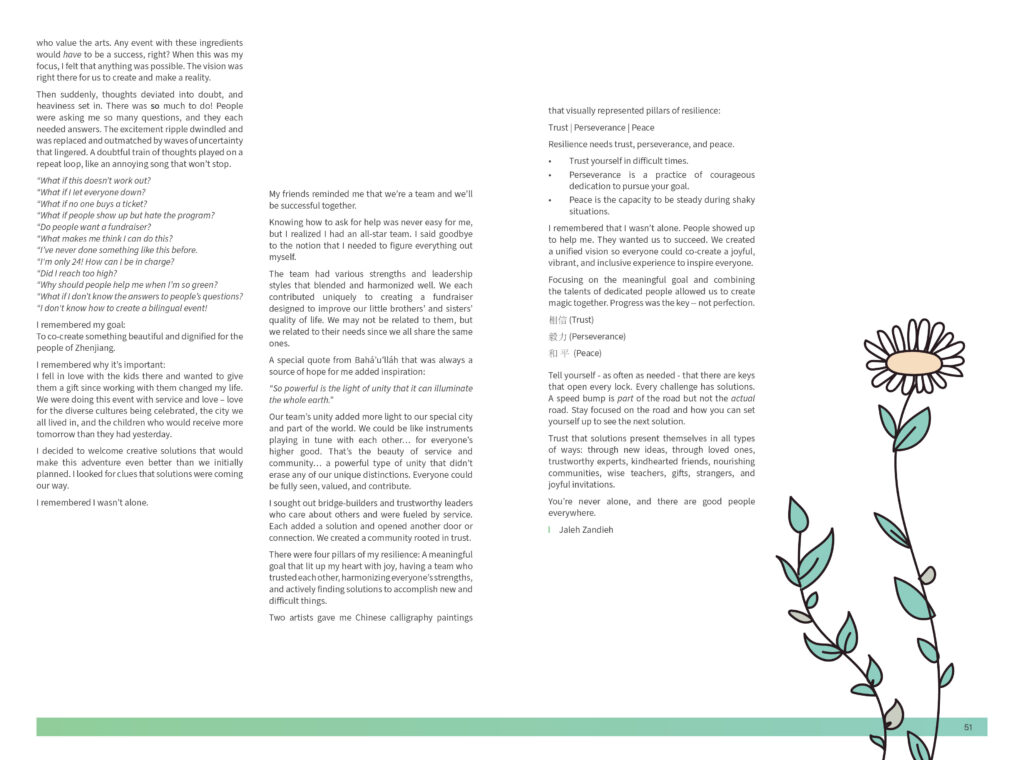After graduate school, I moved to China and wanted to do a good job in my work in a new city, a new country, another culture, and a new language. I became completely overwhelmed with doubt while planning my first bilingual fundraising event that was very close to my heart, and I didn’t want to let anyone down.
I was a 24-year-old graduate from the University of the Sciences in Philadelphia and moved to Zhenjiang, China, to work for an international non-profit organization. My role as a cultural ambassador allowed me to use my new master’s degree to work with local children who didn’t have their own families.
It took time to get used to so many new things, and I felt months passing so quickly. My Mandarin language skills weren’t great, but daily conversations were becoming easier. Instead of a tourist, I felt like I was now part of the city. My friends and neighbors helped build my confidence. One day, I woke up and believed I was in the right place, part of a community, doing meaningful work I loved. I felt at home.
I wanted to keep building on the momentum of so much immersive learning in my new city and focus on doing more service projects for a place I resonated with. So, I decided to extend my contract.
I asked myself questions to gain clarity:
“How can I use my time well?”
“What would make a positive impact on the children here?”
“What would my future self want me to do?”
Time felt like a precious resource passing quickly, and I wanted to use it well. Adoption had always been something I cared about. My first childhood friends were adopted from other countries. We were neighbors, and our families were close. Their parents raised them in loving homes and with opportunities to develop their potential. Having different physical features than their parents wasn’t a barrier to being completely embraced and accepted. They were loved and fully seen.
What if I could help more kids have loving, adopted families like that?
This was the clear nudge I asked for. While working at a local center that provided services to children who didn’t have families of their own, I asked:
“What do they need?
“What would create new opportunities for them to have happy, healthy lives?
Over a conversation at a teahouse, new ideas flowed:
“What if we made a fundraiser for the children and had local artists perform?
“Could we showcase the diverse talents and cultures of people from Zhenjiang and foreigners living there?
The event was called “East Meets West,” we wanted it to unite people of all backgrounds to enjoy an evening of the arts and donate all of the money to children in need.
The team was made up of friends who volunteered to share their time, resources, art, talents, and expertise. We also got sponsors who made donations for the event.
During initial conversations, I had a rush of energy and ideas. My goal went BIG – a program of performances that went above and beyond people’s expectations that led to standing ovations. I visualized the elation of reaching our financial goal and giving the money to the medical director of the children’s center. Our biggest motivation was imagining the faces of our Cutie Pies, who could now be one step closer to being adopted.
We wanted to have a room filled with people who care about improving the quality of life of children and who value the arts. Any event with these ingredients would have to be a success, right? When this was my focus, I felt that anything was possible. The vision was right there for us to create and make a reality.
Then suddenly, thoughts deviated into doubt, and heaviness set in. There was so much to do! People were asking me so many questions, and they each needed answers. The excitement ripple dwindled and was replaced and outmatched by waves of uncertainty that lingered. A doubtful train of thoughts played on a repeat loop, like an annoying song that won’t stop.
“What if this doesn’t work out?
“What if I Iet everyone down?
“What if no one buys a ticket?
“What if people show up but hate the program?
“Do people want a fundraiser?
“What makes me think I can do this?
“I’ve never done something like this before.
“I’m only 24! How can I be in charge?
“Did I reach too high?
“Why should people help me when I’m so green?
“What if I don’t know the answers to people’s questions?
“I don’t know how to create a bilingual event!
I remembered my goal:
To co-create something beautiful and dignified for the people of Zhenjiang.
I remembered why it’s important:
I fell in love with the kids there and wanted to give them a gift since working with them changed my life. We were doing this event with service and love – love for the diverse cultures being celebrated, the city we all lived in, and the children who would receive more tomorrow than they had yesterday.
I decided to welcome creative solutions that would make this adventure even better than we initially planned. I looked for clues that solutions were coming our way.
I remembered I wasn’t alone.
My friends reminded me that we’re a team and we’ll be successful together.
Knowing how to ask for help was never easy for me, but I realized I had an all-star team. I said goodbye to the notion that I needed to figure everything out myself.
The team had various strengths and leadership styles that blended and harmonized well. We each contributed uniquely to creating a fundraiser designed to improve our little brothers’ and sisters’ quality of life. We may not be related to them, but we related to their needs since we all share the same ones.
A special quote from Bahá’u’lláh that was always a source of hope for me added inspiration:
“So powerful is the light of unity that it can illuminate the whole earth.”
Our team’s unity added more light to our special city and part of the world. We could be like instruments playing in tune with each other… for everyone’s higher good. That’s the beauty of service and community… a powerful type of unity that didn’t erase any of our unique distinctions. Everyone could be fully seen, valued, and contribute.
I sought out bridge-builders and trustworthy leaders who care about others and were fueled by service. Each added a solution and opened another door or connection. We created a community rooted in trust.
There were four pillars of my resilience: A meaningful goal that lit up my heart with joy, having a team who trusted each other, harmonizing everyone’s strengths, and actively finding solutions to accomplish new and difficult things.
Two artists gave me Chinese calligraphy paintings that visually represented pillars of resilience:
Trust | Perseverance | Peace
Resilience needs trust, perseverance, and peace.
- Trust yourself in difficult times.
- Perseverance is a practice of courageous dedication to pursue your goal.
- Peace is the capacity to be steady during shaky situations.
I remembered that I wasn’t alone. People showed up to help me. They wanted us to succeed. We created a unified vision so everyone could co-create a joyful, vibrant, and inclusive experience to inspire everyone.
Focusing on the meaningful goal and combining the talents of dedicated people allowed us to create magic together. Progress was the key — not perfection.
相信 (Trust)
毅力 (Perseverance)
和 平 (Peace)
Tell yourself – as often as needed – that there are keys that open every lock. Every challenge has solutions. A speed bump is part of the road but not the actual road. Stay focused on the road and how you can set yourself up to see the next solution.Trust that solutions present themselves in all types of ways: through new ideas, through loved ones, trustworthy experts, kindhearted friends, nourishing communities, wise teachers, gifts, strangers, and joyful invitations.
You’re never alone, and there are good people everywhere.


Are you ready to share your story of RESILIENCE? You can do that HERE.
